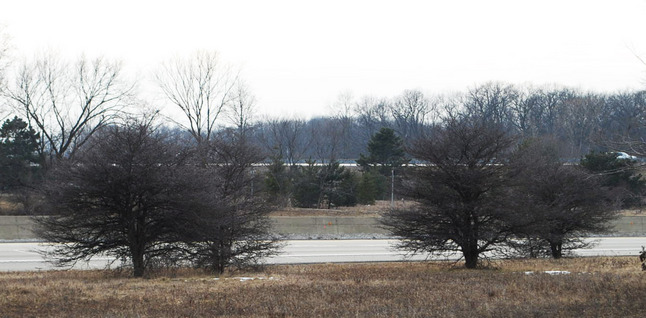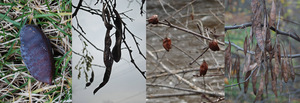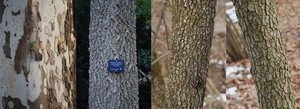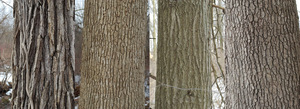The shapes of winter - native trees and shrubs show their character

The horizontal branching of a cluster of Hawthorns (Crataegus spp.) gives passing drivers something nice to enjoy.
Rick Meader |Contributor
Since our springs are typically random weather crap-shoots as to what a particular day will bring, our native trees and shrubs are typically smart enough to keep their leaves huddled in their buds until April or May when the days are much longer. As such, we still have time to enjoy the skeletons of winter, and enjoy some of the shapes presented by our native trees and shrubs. So, in a category format, let’s take a look at some of the shapes and features that will be covered with leaves in a couple of months.
Pods - We talked about these in a stimulating series of entries last winter (on American Bladdernut, Kentucky Coffee Tree and Redbud). I always enjoy seeing the pods of trees and shrubs hanging on through the winter. Kentucky Coffee Tree (Gymnocladus dioica), Honey Locust (Gleditsia triacanthos), Bladdernut (Staphylea trifolia) and Redbud (Cercis canadensis) all have pods of varying sizes and shapes that persist on their branches through the winds of winter, adding interest beyond their branches, and some motion in a light breeze.

The pods of Kentucky Coffeetree (Gymnocladus dioica), Honeylocust (Gleditsia triacanthos), American Bladdernut (Staphylea trifolia) and Eastern Redbud (Cercis canadensis) hang on through the winter, even when their leaves do not.
Rick Meader | Contributor
Bark - Bark is an underappreciated feature of many plants, in my opinion. Sure, it’s not as glamorous as showy flowers, but the intricate patterns of Sycamore (Platanus occidentalis) or Hackberry (Celtis occidentalis), or even the alligator-skin bark of Flowering Dogwood (Cornus florida) make a compelling reason for including them in landscapes. Red osier dogwood (Cornus stolonifera) is primarily added to cultured landscapes for its winter color, when the added sun it gets in winter gives it a brilliant winter “sunburn” that contrasts nicely against the white snow. Of course its berries are an added plus for birds who don’t care as much about the bark.

The distinctive bark of Sycamore (Platanus occidentalis), Northern Hackberry (Celtis occidentalis), Nannyberry (Viburnum lentago) and Flowering Dogwood (Cornus florida) give even the casual plant-watcher something to catch their eye in the winter.
Rick Meader | Contributor
Oak trees’ distinctive bark is a huge aid in identifying them from a distance - black oak (Quercus velutina) has charcoal gray, blocky bark, white oak (Q. alba) has very light grey (almost whitish) bark, red oak (Q. rubra) has “ski map” bark patterns and bur oak (Q. macrocarpa) has thick, ropy bark that withstands frequent fires, which helped it immensely back when prairie/savanna fires were frequent.

When you can't find an acorn, Oak trees' bark can help you tell you which one is in front of you. From left to right, Burr Oak (Quercus macrocarpa), White Oak (Q. alba), Red Oak (Q. rubra) and Black Oak (Q. velutina).
Rick Meader |Contributor
Thorns - While not friendly to the touch, thorns are pretty darn cool, and provide protection for a plant that is more easily avoided in winter because you can see them more easily. Honeylocust thorns are among my favorite. A well-armed tree is quite distinctive, and is a great tool for challenging an obnoxious kid who claims he can climb any tree.
Prickly ash (Xanthoxylum americanum) has twin thorns above its buds that remind one of a preacher raising his arms (versus the thorny bull thorn/bud arrangement of the invasive black locust - an old Woody Plants ID trick). This clonal denizen of wet areas is also a host for the showy Giant Swallowtail butterfly (Papilio cresphontes), and its berries are food for birds. You need to have the right spot for it, but it’s a fun plant, year-round.
While we’re on the subject of thorns, let’s not forget a frequently found small woodland shrub, the Prickly Gooseberry (Ribes cynosbati). Aside from its small and large thorns, it also has a very nice fall color, and is a nice companion to oak trees in your yard.
Branches - They’re the biggest and baddest part of the tree/shrub (compared with the above), so we’ll talk about these last. Branches are the skeleton, and some skeletons are more interesting than others.
For example, Pin Oaks (Quercus palustris) and Black gum (Nyssa sylvatica) both keep their lower branches as they mature, and they hang down to the ground, forming what can appear as the world’s largest bushes when they have leaves on them. In the winter, though, their persistent branches form a unique contrast to most other trees you’ll see.
Jens Jensen and Ossian Simonds, both turn of the century landscape architects in the Prairie style, liked to include Hawthorns (Crataegus species) in their designs, as their horizontal branching pattern evoked the feeling of the vast, horizontal prairies that still existed to some extent in their time. Hawthorns are also great bird magnets, for their berries, and for nesting spots.
Another small tree with distinctive horizontal branching is the pagoda dogwood (Cornus alternifolia), a favorite of mine. This woodland understory tree has very distinct, separate, layers of branches that sweep upward at their ends, creating a distinct look throughout the year, and like all dogwoods, have berries that are favorites of birds, and fall colors that are popular with humans.

The Prickly Ash Preacher (Xanthoxylum americanum) calls for the Great Swallowtail to return to its swampy area, a colorful Prickly Gooseberry (Ribes cynosbati) hides its thorns below its colorful fall leaves, while Pin Oak (Quercus palustris) and Pagoda Dogwood (Cornus alternifolia) show off their horizontal branching.
Rick Meader | Contributor
In conclusion, winter is a great season for botanizing (technical term for plant-watching) for trees and shrubs, and for giving notice to features that might otherwise be missed. These features make all of these plants worthy of your consideration for additions to your personal landscapes, given you have the right situation for them (soils, moisture, sun, and most importantly in some cases, space). The vast majority are available from either Native Plant Nursery or Wildtype Nursery at very affordable prices. I encourage you to branch out and add some of these for increased winter interest in your yard.
You have more daylight after work now, so get out and enjoy the shapes of nature everyone!
Rick Meader is a local landscape architect whose firm, Ecological Edge LLC, specializes in creating designs for homes, businesses and even churches that include a lot of native plants (and the wildlife they attract). You can contact him at ecologicaledgellc@yahoo.com.


Comments
Susan
Sat, Mar 16, 2013 : 2:30 a.m.
Thanks for an interesting article.